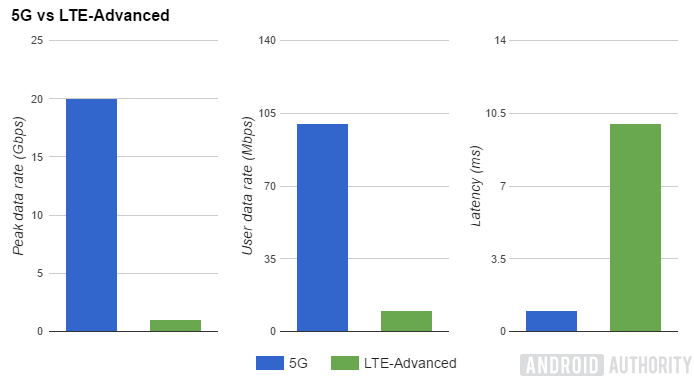The world’s first 5G networks switch on this year, promising faster data speeds and lower latency to consumers. In addition, 5G opens up avenues to new industrial applications and is a critical element to build widely connected “smart cities.” 5G is the next step to provide better networking in our increasingly technological world.
Read Next: Forget mmWave, Wi-Fi is the real 5G
Around the world, companies and governments are ironing out the finer points of how to bring 5G mobile communication to the masses. If you’ve been wondering what is 5G, this is the current state of the industry and what to expect.
What is 5G? It’s all in the details
5G, just like 4G technology, is an evolving standard, which is planned for and created by the 3rd Generation Partnership Project (3GPP) and International Telecommunications Union (ITU). The ITU’s IMT-2020 preparations and 3GPP Release 15 specification lay the foundations for early 5G technology and rollouts.
The specification outlines 5G technology required to build these futuristic networks. High-frequency mmWave base stations, sub-6GHz WiFi-esque small and medium cells, beamforming, and massive multiple-input and multiple-output (MIMO) are just some of the more common technologies talked about. But there are also major changes to data encoding and infrastructure network slicing that are seldom talked about. These are all new technological introductions compared to today’s 4G LTE networks.
How is 5G actually going to work?
4G LTE is already providing millions of customers with super fast data, but with more and more carriers looking to flip the switch on even nippier 1 Gbps networks and phones boasting faster modems, it’s …
The 5G standard is split into two key parts – Non-Standalone (NSA) and New Radio (NR). Today’s first 5G networks will be based on NSA, and are planned to eventually transition over to SA once that part of the specification is finalized in the coming years. Complicating the situation further, U.S. carrier Verizon has its own version of 5G to accelerate its rollout. However, Verizon plans to adopt the mainstream 5G later.
5G networks are built from a wide range of technologies
5G technology explained
The most commonly talked 5G technology is mmWave, but carriers will also be utilizing new spectrum in the sub-6GHz WiFi region, low bands below 1GHz, and existing 4G LTE bands too. There is currently lots of unused high-frequency spectrum, known as millimeter wave. The higher the frequency the more bandwidth is available, but the trade-off is that this technology has a shorter range than lower frequencies used in 4G LTE.
The overall idea is to greatly increase the amount of spectrum available by combining the pros and cons of all these different frequencies. Combining more spectrum with carrier aggregation (sending data over multiple pieces of spectrum) allows for more bandwidth and much faster speeds for consumers.

5G greatly increases the amount of spectrum used to send and receive data.
Here’s a breakdown of the key 5G technology terms that you need to know.
- mmWave – very high frequency between 17 and 100GHz and high bandwidth for fast data. Most carriers are targeting use in the 18-24GHz range. Reasonably short-range technology that will be used in densely populated areas.
- Sub-6GHz – operates in WiFi-like frequencies between 3 and 6GHz. Can be deployed in small cell hubs for indoor use or more powerful outdoor base stations to cover medium range much like existing 4G LTE. Most 5G spectrum will be found here.
- Low-band – very low frequencies below 800MHz. Covers very long distances and is omnidirectional to provide blanket backbone coverage.
- Beamforming – used in mmWave and sub-6GHz base stations to direct waveforms towards consumer devices, such as bouncing waves off buildings. A key technology in overcoming the range and direction limitations of high-frequency waveforms.
- Massive MIMO – multiple antennas on base stations serve multiple end-user devices at once. Designed to make high-frequency networks much more efficient and can be combined with beamforming.
Although lots of carriers like to talk up fancy advancements in mmWave technology, 5G networks will actually be a combination of everything. The various technologies can be thought of in three tiers, which Huawei explains neatly in many of its papers.
Low bands that can be repurposed from radio and TV make up the “coverage layer” at sub 2GHz. This provides wide-area and deep indoor coverage and forms the backbone of the network. There’s the “Super Data Layer” made up of high-frequency spectrum known as mmWave that suits areas requiring extremely high data rates or population coverage. Then the “coverage and capacity layer” sits between 2 and 6 GHz, which offers a good balance between both.
In a nutshell, 5G allows consumers to connect to and leverage the benefits of this wide range of spectrum for faster, and more reliable coverage.

5G Non-standalone vs standalone
The key to understanding the differences between 5G NSA and SA lies in the network backend. The first 5G networks based on the NSA standard use existing 4G LTE infrastructure to handle the Control Plane. The Control Plane handles the signal traffic, managing how user devices connect to base stations, checking subscriptions, etc. Meanwhile, the data plane is what you and I actually use to send and receive data.
In a sense, 5G NSA can be thought of as just having an extra fast data pipe attached to existing 4G LTE infrastructure. The adoption of the 5G Standalone (SA) specification sees the control plane transition over to the 5G Core and marks much bigger changes for the way that networks operate.

TVS 5G Standalone implements the 5G Core and Control Plane.
In addition to introducing the Control Plane over 5G radio technologies, Standalone supports more flexible Network Slicing and subcarrier encoding.
Network Slicing is a form of virtual networking architecture enabling greater flexibility to partition, share, and link parts of the back-end network together. This will allow network operators to offer more flexible traffic, applications, and services to their customers. This idea is seen as key to realizing ideas such as autonomous vehicles and smart cities.
The changes to subcarriers are a little harder to explain. Technologies encompassed by this include scalable OFDM and sub-carrier spacing, windowed OFDM, flexible numerology, and scalable Transmission Time Intervals. Put simply, frames that carry data can be bigger and faster when higher throughput at high efficiency is required. Alternatively, these frames can be made smaller in order to achieve much lower latency for real-time applications.
The first 5G networks will be based on the non-standalone specification, before bigger changes with the full standalone specification after 2021.
Network slicing can already be done with 4G networks, but 5G aims to improve on the range of flexibility and standardize support. The yet to be finalized 5G Standalone (SA) specification (3GPP Release 16) will divulge more detail on the back-end technologies which will power next-gen networks.
Read Next: Don’t believe the carriers, the 5G revolution is still years away (SA vs NSA)

What does 5G mean for consumers?
More important than the question “what is 5G”, is how it will actually affect consumers. Bottom-line, if you have a need for speed, 5G will help open up new doors.
IMT-2020 5G radio base stations will have to offer at least 20Gbps download and 10Gbps upload speeds to consumers. This refers to a shared link, so actual speeds will be lower. The specification states individual users should see a minimum download speed of 100Mbps and upload speeds of 50Mbps. Some of you might be lucky enough to see these speeds on your LTE-Advanced network already, but this will become a baseline level for all consumers on 5G networks.
5G vs Gigabit LTE: the differences explained
5G is coming this year, if some carriers are to be believed. But you won’t find a phone able to make use of 5G until at least 2019. Meanwhile, other networks and equipment manufacturers have been …
5G base stations will have to cover stationary users all the way up to vehicles traveling up to 500km/h (310~ miles), so your data connection hopefully won’t drop out on the train in the future. Fifth generation networks should offer consumers a maximum latency of just 4ms. There’s mention of a 1ms latency for ultra-reliable low latency communications (URLLC) too. For comparison, my 4G LTE connection in London has a questionable 82ms latency, while the U.S. average is around 61 ms.
5G also wants to enable simultaneous connectivity to thousands of low power internet of things (IoT) devices and support device-to-device (D2D) connectivity for low latency connections between nearby devices.
5G vs 4G – key differences
Compared to 4G LTE, 5G networks will be consistently faster. Minimum user rate speeds increase from just 10Mbps to 100Mbps, a 10x increase. Latency is set to fall by a similar amount, from 10ms to just 1ms when compared to LTE-Advanced. The big increase in bandwidth also means that 5G will be able to handle up to one million devices per square kilometer, another 10 fold increase over LTE-A, all with a 10x boost to network energy efficiency.

| |
5G New Radio
(Release 15) |
LTE-Advanced Pro
(Release 13 & 14) |
LTE-Advanced
(Release 10 to 12) |
| User Data Rate |
> 10 Gbps |
> 3 Gbps |
> 1 Gbps |
| Latency |
> 1ms |
> 2ms |
~10 ms |
| Frequency Support |
Up to 40 GHz |
Up to 6 GHz |
Up to 6 GHz |
| Channel Bandwidth |
Up to 500 MHz |
Up to 20 MHz |
Up to 20 MHz |
| Max carriers |
16 (LTE + NR) |
32 |
5 |
| Max Bandwidth |
1000 MHz |
640 MHz |
100 MHz |
| MIMO antennas |
64 to 256 |
32 |
8 |
| Spectrum Sharing |
mmWave & NR
Dual Connectivity
NR-based LAA+
NR MulteFire
LTE-U |
LAA / eLAA
LWA
MulteFire
CBRS / LSA
LTE-U |
LTE-U (Rel. 12) |
As we have covered previously, the range of networking technologies greatly increases too. LTE has undergone many improvements over the years. From the introduction of 256QAM and carrier aggregation with LTE-A to support for wider use of unlicensed spectrum through LAA, LWA, and Multefire with LTE-A Pro. This is why today’s 4G network is much faster than those built during the initial rollout all those years ago.
5G advances another step further, mandating the use of 256QAM and improving carrier aggregation technology to support more flexible carrier bands across unlicensed spectrum, sub-6GHz, and mmWave frequencies. The image below from Arm all the way back in 2016 explains this core difference rather succinctly.

5G networks around the world
The world is gearing up for the launch of 5G, both network operators and device manufacturers. As with the adoption of 4G LTE networks, 5G will be a staged process and some countries will launch their networks well ahead of others.
Mid-2019 is the date to keep an eye on, as both 5G smartphones and networks will be available to the first wave of consumers. However, deployment is not expected to ramp up on a more global scale until 2020 and 2021. Even by 2023, it’s anticipated that just 50 percent of consumers will have a 5G smartphone and network connection.
U.S. 5G rollout
The U.S. will be the first country to flick on its 5G networks across a number of carriers and in a decent selection of cities in the first half of 2019. U.S. carriers have been some of the biggest advocates of millimeter wave technology. Verizon is already the first with consumer 5G via its fixed wireless access service, but Sprint and T-Mobile are close behind with rollouts planned for mid-2019. We’re actually waiting for 5G smartphones to arrive so that consumers can start using these networks on the go.
However, one of the country’s carriers has already been caught out playing fast and loose with the 5G term. AT&T’s “5G Evolution” is not a 5G network in any sense of the word, it’s simply an evolution of today’s LTE-Advanced networks.
If you want to keep up with all the latest deployment details as each U.S. carrier carries out their 5G rollout, check out the links below.
Europe trails the leaders
Europe is trailing behind the U.S. and the continent’s first 5G networks aren’t expected to switch on until late 2019 at the earliest. Although wider deployments aren’t scheduled until 2020 or later.
The UK is likely to be first with 5G available in major cities. EE is planning to launch its service in 16 cities this year. Meanwhile, O2, Vodafone, and Three still look set for a 2020 5G launch date. On the continent, operators have brought forward some of their plans, but major players Orange, Deutsche Telekom, and Telefonica have only committed to a 2020 launch timeframe.
Part of this delay is that the European telecommunications ministers only unveiled their 5G roadmap for the block at the end of 2017.
Technical harmonization across spectrum bands isn’t scheduled to begin until 2019, with low-frequency 700MHz assignment scheduled for 2020 and availability expected even later in 2022.
Ambitious Asia
Japan and South Korea have been leading infrastructure tests throughout the 5G development cycle and will be right up there with the U.S. when they deploy.
In South Korea, major carriers are expecting commercial 5G deployment in the first half, if not the first quarter of 2019. A nationwide rollout is expected to be complete by 2022. In Japan, the 2020 Olympics are the next target for 5G millimeter wave trials in dense urban areas, and an agreement between Nokia and NTT DoCoMo will see commercial services begin later that year.
China is quickly becoming a major 5G player, tipped to accelerate past its Asian rivals and compete with the U.S. for deployment time. The country is home to major telecom infrastructure companies like Huawei and ZTE, which will provide equipment to carriers around the world. China has also invested $180 billion into mainland infrastructure, four times Japan’s investment. China Mobile is trialing its services in major cities this year and plans a full commercial launch in 2020.

What about 5G smartphones?
There currently aren’t any smartphones built for 5G networks on the market. Unless you count the 5G Moto Mod available for Motorola’s Moto Z3. Still, a number of smartphone manufacturers are talking up 5G smartphone releases for 2019. Most of which will likely appear around the halfway point of the year.
There currently aren’t any smartphone processor chips with integrated 5G modems inside them. Instead, phone manufacturers have to pair up existing processors with external 5G modems, along with the required radio antenna modules. So we shouldn’t expect the first 5G phones to be any more powerful than their 4G LTE rivals. In fact, they may require bigger batteries to cope with the extra 5G power drain.
The first Samsung 5G smartphone is likely to be a dedicated variant of the Galaxy S10. The expected release date is presumed to be Spring 2019. Likewise, Huawei is expected to have its first 5G phone ready for the second half of 2019, but recently that estimate moved to Q1 2019. OnePluswill launch a 5G phone in 2019. And of course a number of other major manufacturers, including LG, HTC, and Oppo, are all confirmed to be working with Qualcomm’s X50 modem for upcoming phones.
5G frequency bands
Just like with 4G, networks and smartphones will support different frequency bands for data transfer. In addition to the existing LTE bands, 5G New Radio standardizes a number of new ones for upcoming networks. 5G is split into two ranges, the first for frequencies between 400MHz and 6GHz. Range 2 accounts for mmWave bands between 24 and 53GHz.
| 5G Band |
Uplink Frequency |
Downlink Frequency |
Bandwidth |
Channel Bandwidths |
Type |
| n1 |
1920 -1989 MHz |
2110 – 2170 MHz |
60 MHz |
5, 10, 15, 20 MHz |
FDD |
| n2 |
1850 – 1910 MHz |
1930 – 1990 MHz |
60 MHz |
5, 10, 15, 20 MHz |
FDD |
| n3 |
1710 – 1785 MHz |
1805 – 1880 MHz |
75 MHz |
5, 10, 15, 20, 25, 30 MHz |
FDD |
| n5 |
824 – 849 MHz |
869 – 894 MHz |
25 MHz |
5, 10, 15, 20 MHz |
FDD |
| n7 |
2500 – 2670 MHz |
2620 – 2690 MHz |
70 MHz |
5, 10, 15, 20 MHz |
FDD |
| n8 |
880 – 915 MHz |
925 – 960 MHz |
35 MHz |
5, 10, 15, 20 MHz |
FDD |
| n20 |
832 – 862 MHz |
791 – 821 MHz |
30 MHz |
5, 10, 15, 20 MHz |
FDD |
| n28 |
703 – 748 MHz |
758 – 803 MHz |
45 MHz |
5, 10, 15, 20 MHz |
FDD |
| n66 |
1710 – 1780 MHz |
2110 – 2200 MHz |
90 MHz |
5, 10, 15, 20, 40 MHz |
FDD |
| n70 |
1695 – 1710 MHz |
1995 – 2020 MHz |
15/25 MHz |
5, 10, 15, 20, 25 MHz |
FDD |
| n71 |
663 – 698 MHz |
617 – 652 MHz |
35 MHz |
5, 10, 15, 20 MHz |
FDD |
| n74 |
1427 – 1470 MHz |
1475 – 1518 MHz |
43 MHz |
5, 10, 15, 20 MHz |
FDD |
| n38 |
2570 – 2620 MHz |
2570 – 2620 MHz |
50 MHz |
5, 10, 15, 20 MHz |
TDD |
| n41 |
2469 – 2690 MHz |
2496 – 2690 MHz |
194 MHz |
5, 10, 15, 20, 40, 50, 60, 80, 100 MHz |
TDD |
| n50 |
1431 – 1517 MHz |
1432 – 1517 MHz |
85 MHz |
5, 10, 15, 20, 40, 50, 60, 80 MHz |
TDD |
| n51 |
1427 – 1432 MHz |
1427 – 1432 MHz |
5 MHz |
5 MHz |
TDD |
| n77 |
3300 – 4200 MHz |
3300 – 4200 MHz |
900 MHz |
5, 10, 15, 20, 40, 50, 60, 80, 100 MHz |
TDD |
| n78 |
3300 – 3800 MHz |
3300 – 3800 MHz |
500 MHz |
5, 10, 15, 20, 40, 50, 60, 80, 100 MHz |
TDD |
| n79 |
4400 – 5000 MHz |
4400 – 5000 MHz |
600 MHz |
40, 50, 60, 80, 100 MHz |
TDD |
| n75 |
– |
1432 – 1517 MHz |
85 MHz |
5, 10, 15, 20 MHz |
SDL |
| n76 |
– |
1427 – 1432 MHz |
5 MHz |
5 MHz |
SDL |
| n80 |
1710 – 1785 MHz |
– |
75 MHz |
5, 10, 15, 20, 25, 30 MHz |
SUL |
| n81 |
880 – 915 MHz |
– |
35 MHz |
5, 10, 15, 20 MHz |
SUL |
| n82 |
832 – 862 MHz |
– |
30 MHz |
5, 10, 15, 20 MHz |
SUL |
| n83 |
703 – 748 MHz |
– |
45 MHz |
5, 10, 15, 20 MHz |
SUL |
| n84 |
1920 – 1980 MHz |
– |
60 MHz |
5, 10, 15, 20 MHz |
SUL |
| n257 |
26.5 – 29.5 GHz |
26.5 – 29.5 GHz |
3 GHz |
50, 100, 200, 400 MHz |
TDD |
| n258 |
24.250 – 27.5 GHz |
24.250 – 27.5 GHz |
3.250 GHz |
50, 100, 200, 400 MHz |
TDD |
| n260 |
37 – 40 GHz |
37 – 40 GHz |
3 GHz |
50, 100, 200, 400 MHz |
TDD |
Related
Source: Android Zone
The post What is 5G, and what can we expect from it? appeared first on TuneMaster.ml.















































